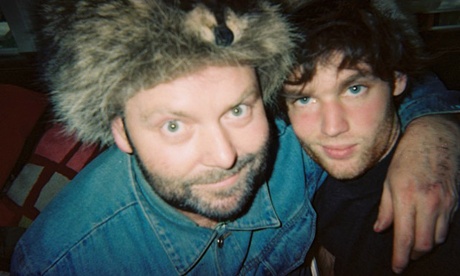
Getting shot is not what I expected it to be. I had drunk a bottle of vodka and the shock was greater than the pain. My mouth was suddenly dry and then, as I looked down at my leg, it filled with a sweet wooziness.
This was in the first few months of writing Adam Cullen’s biography, Acute Misfortune. The painter was still testing my dedication to the project. Later, he would throw me from a motorcycle as we took the hairpin bend that held his house in place on the edge of Wilson Park at Wentworth Falls. The smile Adam gave as he doubled back and offered me his hand was a smile I came to know well. So was the question: “How was that?”
Adam was never satisfied until he knew where the boundaries were, until he knew how far he could push a person. “I have heard this a few times from people,” he told me early in our interviews. “‘I can’t spend too much time with you, Adam. You’re too dangerous.’ I do take things a bit far, but it’s not with other people. It’s with myself.”
I was 19 when he invited me to stay in his spare room and write his biography. A publisher wanted it, he said. He was sick and ready to talk.
I was interested in Adam. At the time, he was the country’s only artist celebrity. His misdemeanors made the front pages of newspapers. He always hovered on the precipice of controversy. When journalists called, he was invariably good for a quote.
I was disbelieving of his stories. He was playing at a character, a cliché of the untamed artist, and I was keen to unpick this. For the first six months of what became four years of interviews, our conversations were embroidered with lies. With time, these came apart.
The wild man, who towards the end of his life faced court on multiple weapons charges, was at heart a boy who wished never to grow up. He had been made lonely by this wish – isolated by a drug habit that rendered the course of his life inevitable and its conclusion too obvious.
Eventually, I came to realise that the book contract did not exist. Adam had invented it so I might spend time with him. He shot me to see if I would be scared off. When I wasn’t, he started to talk to me honestly.
Early on, he admitted the difficulties he had loving his mother, how he rejected the richness of her breast milk and felt this formed some glib epigraph to the relationship that followed. “I just never took to the love of a mother,” he said. “I couldn’t stomach it.”
We talked about the crutch heroin had become, how he depended on it. “It puts some space between me and the work, and I think I need that.”
Finally, just before his death at 46, he confessed that he had spent his life a closet bisexual. He was in love with me. “It’s alright,” he said as he forced his arms around me in this late interview. “I’m not going to fuck you.”
Biography is a strange task. It is part therapy, part reconstructive surgery. I worked for four years to get behind Adam’s facade, the front he had spent two decades constructing, and once there I found myself in a place of claustrophobic intimacy. The ordinary boundaries fell away. When Adam died, I held onto the words of our first meeting: “Everything is on the record. Everything else is fucking gutless.”
Death hung over my entire time with Adam. Biographies look naturally for conclusions, I think. Rarely are they written in health. All journalism is trespass and trespass is as much about entry as it is about exit.
Adam welcomed this trespass. He encouraged me through his front door and into his cupboards and drawers. He laboured at his meaning, to be certain it would not be lost. He was careful with the knowledge of what he would leave behind. “I could do a lot of damage,” he was fond of saying, “and leave a lot of aesthetic residue.”
There were things Adam wanted written down, messy thoughts he wanted to be sure would outlive him. This is the biographer’s task: to sort legacy from myth.
Adam died and it wrecked me like I never expected it would. When I carried his coffin, I felt a weight I could not for some time comprehend. Locked in my trespass I looked for an exit. I sat down and wrote this book.
Mostly, I tried to keep myself out of it. I tried, I think, to fill his coffin – the one his battered body left too empty, which still weighed too much. I tried to answer a simple question: why did this talent, who changed the Archibald Prize by winning it and produced some of the most sublime work of his generation, die?
I looked, sometimes with difficulty, through the time I knew him. I combed my shorthand. Still there in my mind was our first meeting. He told me, unprompted, that he was going to die. Unbuttoning his shirt, his stomach like an overstuffed carpetbag, he showed me the scar that twisted the length of his torso – vestige of the pancreatitis operation that earlier filleted him of a gall bladder and various bits of other organs.
I asked him what had happened, to fill the silence more than anything. “Acute misfortune,” he said. “I think the art world caused this.”
• Erik Jensen is the editor of The Saturday Paper. His first book, Acute Misfortune: The Life and Death of Adam Cullen, is out now through Black Inc.

